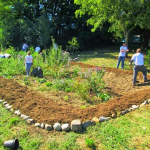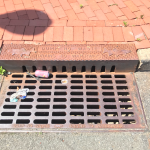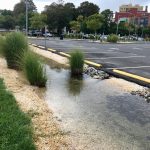New Jersey Future Blog
One Year Later: How NJ Municipalities Have Implemented DEP’s Stormwater Management Rules
June 27th, 2022 by Sasha Weber
It has been just over a year since New Jersey Department of Environmental Protection’s (NJDEP) 2020 amendment to the Stormwater Management Rule (NJAC 7:8) took effect. Since March 2, 2021, NJ municipalities have been required to utilize green infrastructure—systems that mimic natural hydrologic processes to capture and reuse stormwater—as a stormwater management technique on all new public and private major developments (see our March 2021 article for an overview of the new stormwater rules). Localities carry out these requirements through their Stormwater Control Ordinances.
Once enacted, Stormwater Control Ordinances set a threshold for the size of an individual development project. If the project disturbs more than one acre of land, NJDEP requires that it employ green infrastructure. If it disturbs less than one acre of land, green infrastructure is not required.
As of August 2021, 291 New Jersey municipalities have updated their Stormwater Control Ordinances to meet these green infrastructure requirements. Several of these localities have gone above and beyond to further protect their communities from flooding and pollution associated with inadequately managed stormwater.
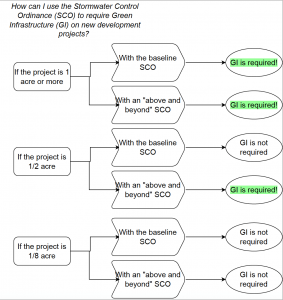
Stormwater Control Ordinances can be used to require green infrastructure. Image Credit: Andrew Tabas
What Constitutes “Above and Beyond?”
In the Enhanced Model Stormwater Ordinance for Municipalities, New Jersey Future (NJF) highlights several steps that municipalities can take to further enhance their Stormwater Control Ordinances and go above and beyond DEP’s requirements. These recommendations for advancement include redefining the threshold for “Major Development;” adding a definition and requirements for “Minor Development;” requiring stormwater management on existing (not just new) impervious surfaces; requiring infiltration of a specific volume of stormwater onsite; and reducing “maximum contributory drainage areas.” All of these changes would increase the amount of green infrastructure in localities.
Case Studies
Curious how some municipalities have implemented and/or gone above and beyond NJDEP’s requirements to reap the benefits of green infrastructure? Check out the following case studies to learn how these requirements are put into action.
Princeton
Princeton defines “major development” as development that disturbs ½ acre or more land or includes 5,000 square feet of impervious surfaces. This requires green infrastructure on more sites than would have been required under NJDEP’s standard definition. Additionally, Princeton requires green infrastructure on “minor development projects.” Regarding the definition of Minor Development by Princeton, Jim Purcell, Princeton’s Assistant Municipal Engineer, shared that “400 square feet “came from an analysis of other municipalities and our own threshold of 500 [square feet]. Another town uses 250, so we settled on 400.”
Since the state requirements went into effect, Princeton has approved a number of projects that implement green infrastructure. For example, there is a recently-dedicated Habitat for Humanity house in Princeton which utilizes several rain barrels, and the municipality also has a rain garden with an underdrain.
Jersey City
Like Princeton, Jersey City also goes above NJDEP’s requirements by employing a definition for “minor development” and modifying the state’s definition of Major Development. Where the NJDEP begins the green infrastructure requirement with projects that disturb more than one acre (43,560 square feet) of land in its Major Development definition, Jersey City includes projects starting at 5,000 square feet in the Minor Development definition. Lindsey Sigmund, an Environmental Planner for Jersey City, worked with the Jersey City Municipal Utilities Authority (JCMUA) to develop this definition.
A recently-approved warehouse for 440 Warehouse Developers LLC with several bioretention basins highlights the new stormwater management requirements.
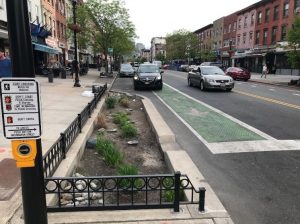
Green infrastructure in Hoboken, NJ captures stormwater while making streets more welcoming. Photo credit: Andrew Tabas.
Hamilton
Hamilton, the largest suburb of Trenton, located within the Delaware River Watershed, meets NJDEP’s requirements in their 2021 Stormwater Control Ordinance. A proposal by Vessel RE Holdings LLC for a multi-family housing development consisting of 60 apartment units across five buildings is considered a Major Development. As such, the project’s Engineering Review from April 2022 notes that the development “includes a combined extended detention and infiltration system to address quantity, quality, and recharge.
For more information and resources on green infrastructure, visit New Jersey Future’s Mainstreaming Green Infrastructure website.
Related Posts
Tags: Development, green infrastructure, municipalities, Stormwater, stormwater management rules

